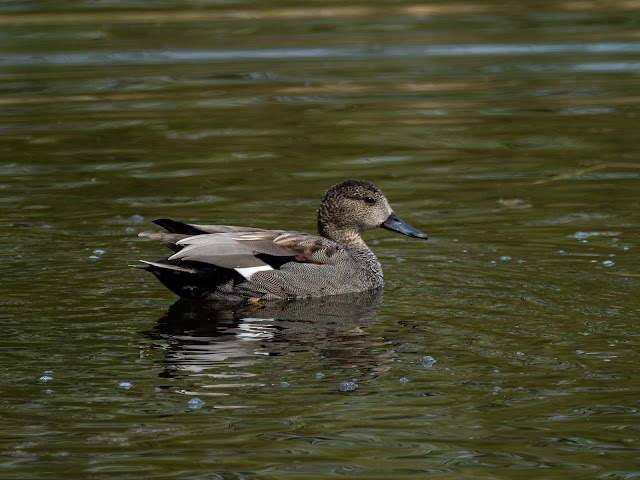This was my first visit to RSPB
Rye Meads in Hertfordshire since April 2014. It is another site that is relatively easy for me to visit by
public transport: bus to Billericay, train to London Liverpool
Street followed by another train to Rye House and then a short walk to the
reserve entrance.
Rye Meads is a 58.5 hectare
biological Site of Special Scientific Interest (SSSI) located in Rye House near Hoddesdon in Hertfordshire. It is one of
series of wetlands and reservoirs situated along the River Lea
to the north east of London. It is part of the Lea Valley RAMSAR
site (a group of internationally important wetland sites) and
a Special Protection Area (SPA).
Rye Meads is divided into several areas. North of Rye Road is
the Rye Meads nature reserve: the
western half of this nature reserve, next to the River Lea in
the Lee Valley Regional Park, is managed by the RSPB and
the eastern half is managed by the Hertfordshire and Middlesex Wildlife Trust. It also includes a
meadow and lagoons owned by Thames Water south of
Rye Road which is not open to the public.
I visited the RSPB Rye Meads reserve
which includes a visitor centre, trails and a number of hides. The seasonal flooding of a large ancient flood
meadow combined with the rich soils has resulted in a mosaic of habitats,
consisting of reedbeds, marshy grasslands and fen vegetation plus a number of
small lakes and a scrape.
Amongst other species, RSPB Rye Meads is well known for its breeding Kingfishers which can be easy to see and photograph with a bit of patience and this species was my main target for the day.
Since my last visit to RSPB Rye Meads, an old hide overlooking a small lake with an artificial sand bank created for nesting Kingfishers has been replaced by a new Kingfisher Hub.
2022 at the Kingfisher Hub
My first sighting of a Kingfisher was of a male from the first hide (the Draper Hide). This hide overlooks a scrape which was very active with many birds. To the left of the hide is another artificial sand bank created for nesting Kingfishers. The visitor centre volunteer told me that they were not certain if a pair of Kingfishers was breeding here but a male periodically turned up with a fish in its beak and sat on the same perch in the bushes adjacent to the nesting holes.
Photo: male Kingfisher from the Draper Hide
Photo: male Kingfisher from the Draper Hide
At the Kingfisher Hub, I had to wait for around an hour to see the pair of Kingfishers that are definitely nesting in the artificial sand bank. After this long wait, which at least provided opportunities to watch and photograph other birds, I heard the distinctive short, sharp whistle of a Kingfisher and a female flew in and landed on a branch outside the nest. The male Kingfisher emerged from one of the nest holes and joined it. They sat together for perhaps a minute or so until the nest change-over was completed with the female going in to the nest hole and the male remaining briefly on the branch before flying off.
Photo: male and female Kingfisher from the Kingfisher Hub
Photo: male and female Kingfisher from the Kingfisher Hub
Photo: male Kingfisher from the Kingfisher Hub
Photo: male Kingfisher from the Kingfisher Hub
The 3 Kingfishers were definitely the highlight of my visit but I also I added a further 2 species to my 2022 year list taking it to a current total of 137 species: 2 singing male Sedge Warblers (1 briefly seen) and 3 Red-crested Pochards (2 males and a female).
Photo: male Red-crested Pochard
Other notable records included the following: Chiffchaff (1 singing male plus at least 4 other singing males heard), Blackcap (3 singing males seen plus 2 other singing males heard), Cetti's Warbler (at least 6 singing males heard), Stock Dove (1), Lapwing (2), Great Crested Grebe (4), Little Grebe (7), Mute Swan (4), Egyptian Goose (1), Canada Goose (10), Water Rail (1 heard calling), Moorhen (c.10), Coot (c.20), Cormorant (1), Gadwall (c.25),Tufted Duck (c.25), Shoveler (c.25), Mallard (c.20 including a pair with 8 ducklings), Common Pochard (c.10), Teal (c.10), Lesser Black-backed Gull (2), Black-headed Gull (c.200)
Other miscellaneous records included the following: Orange Tip (3 .... first record of the year), Speckled Wood (1) and Brown Rat (1).
Here are some other photos from my visit ....
Photo: Great Crested Grebe
Photo: Great Crested Grebe
Photo: male and female Gadwall
Photo: male Gadwall
Photo: Lapwing
Photo: Lesser Black-backed Gull
Following my visit, I adjourned to the
The Rye House nearby to enjoy some real ale and excellent food before travelling home.


💚🦆 🦉🦋🐝🦊🦡🌼 🌳💚
Stay safe, stay well, stay strong, stay connected with nature



































No comments:
Post a Comment
If you feel like commenting on my blog, you can contact me by completing the comment form below. I will respond to all comments and enquiries and constructive criticism will always be welcomed.